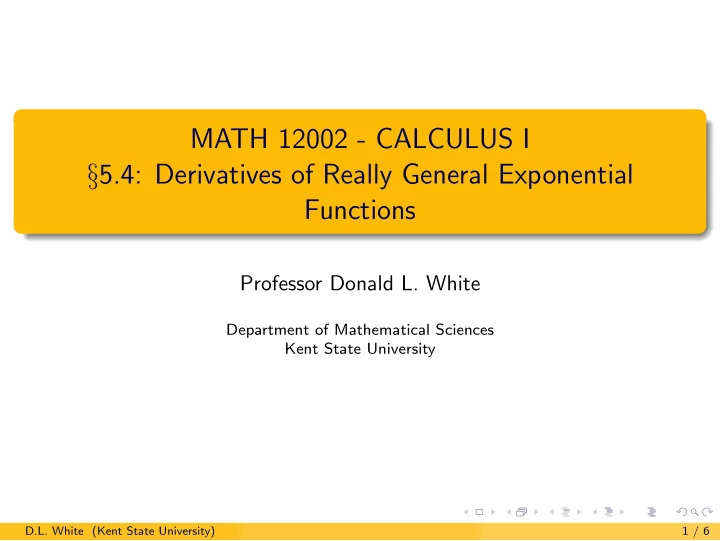

MATH 12002 - CALCULUS I § 5.4: Derivatives of Really General Exponential Functions Professor Donald L. White Department of Mathematical Sciences Kent State University D.L. White (Kent State University) 1 / 6
Even More General Exponential Functions We have the differentiation formulas d dx x n = nx n − 1 if n is constant and d dx a x = (ln a ) a x if a is constant . So what is the derivative of f ( x ) = x x ? dx x x is NOT x · x x − 1 (which is x x ). d Since the exponent is not constant, dx x x is NOT (ln x ) x x . d Since the base is not constant, For a REALLY general exponential function of the form f ( x ) g ( x ) , we use logarithmic differentiation. D.L. White (Kent State University) 2 / 6
More Examples Find the derivatives of the following functions: 1 f ( x ) = x x First, we set y = x x , and then take natural logs of both sides: ln y = ln x x . Next, use the “Power” Law of Logarithms, ln( a r ) = r ln a , to eliminate exponents: ln y = x ln x . Finally, take derivatives, with respect to x , of both sides: y y ′ = 1 · ln x + x · 1 1 x and then multiply both sides by y , recalling that y = x x : y ′ = y (ln x + 1) = x x (ln x + 1) . Hence f ′ ( x ) = x x (ln x + 1). D.L. White (Kent State University) 3 / 6
More Examples 2 f ( x ) = ( x 2 + 3) tan x Again using logarithmic differentiation, we set y = ( x 2 + 3) tan x , and have ( x 2 + 3) tan x � � ln y = ln (tan x ) ln( x 2 + 3); = 1 1 (sec 2 x ) ln( x 2 + 3) + (tan x ) y y ′ = x 2 + 3 · 2 x ; � � (sec 2 x ) ln( x 2 + 3) + 2 x tan x y ′ = y x 2 + 3 . � (sec 2 x ) ln( x 2 + 3) + 2 x tan x � Hence f ′ ( x ) = ( x 2 + 3) tan x . x 2 + 3 D.L. White (Kent State University) 4 / 6
More Examples Note: Logarithmic differentiation is necessary only if both the base and exponent are non-constant. It will work with normal exponential and power functions, using the fact that the derivative of a constant function is 0. 3 Use logarithmic differentiation to find the derivative of f ( x ) = 5 x 3 +4 . Set y = 5 x 3 +4 , so that ln y = ln(5 x 3 +4 ) = ( x 3 + 4) ln 5 . Since ln 5 is just a constant, taking derivatives we get 1 y y ′ = 3 x 2 ln 5 , and so y ′ = y · 3 x 2 ln 5. Hence f ′ ( x ) = 3 x 2 (ln 5)5 x 3 +4 . dx 5 x = (ln 5)5 x , d This is the same answer we would get using but requires much more work. D.L. White (Kent State University) 5 / 6
More Examples 4 Use logarithmic differentiation to differentiate f ( x ) = ( x 3 + 4) 5 . Set y = ( x 3 + 4) 5 , so that ln y = ln[( x 3 + 4) 5 ] = 5 ln( x 3 + 4) . Since 5 is just a constant, taking derivatives we get 1 1 y y ′ = 5 · x 3 + 4 · 3 x 2 , and so y ′ = ( x 3 + 4) 5 · 5 · 3 x 2 x 3 + 4 . Hence f ′ ( x ) = 5( x 3 + 4) 4 · 3 x 2 . dx x 5 = 5 x 4 , d This is the same answer we would get using but again requires much more work. D.L. White (Kent State University) 6 / 6
Recommend
More recommend